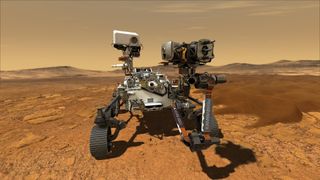
The touchdown of NASA's next Mars rover is less than a month away.
The car-size Perseverance rover, the core of NASA's $2.7 billion Mars 2020 mission, will land Feb. 18, kicking off a new era of Red Planet exploration.
On that fateful day, a rocket-powered sky crane will lower Perseverance to the floor of the 28-mile-wide (45 kilometers) Jezero Crater, which hosted a lake and a river delta billions of years ago. Over the course of its mission, Perseverance will scour Jezero for signs of ancient Mars life and collect and cache dozens of samples.
In photos: NASA's Mars Perseverance rover mission to the Red Planet
If all goes according to plan, those samples will be hauled to Earth as early as 2031 by a joint NASA-European Space Agency campaign, in humanity's first-ever Mars sample-return effort.
Mars 2020 is historic in other ways as well. NASA hasn't actively hunted for signs of Mars life since the twin Viking missions, which launched in the mid-1970s. (Perseverance's predecessor, the still-productive Curiosity rover, is assessing Mars' past habitability but isn't equipped to search for life itself.) And traveling to the Red Planet on Perseverance's belly is a tiny helicopter named Ingenuity, which will try to become the first rotorcraft ever to fly on a world beyond Earth.
Perseverance is also designed to help pave the way for human exploration of Mars. For example, one of the rover's instruments, called MOXIE (short for "Mars Oxygen ISRU Experiment"), will generate oxygen from the carbon dioxide-dominated Martian atmosphere — technology that, if scaled up, could help our species get a foothold on the Red Planet, NASA officials have said. (ISRU, in turn, stands for "in situ resource utilization," a fancy term for living off the land.)
Get the Space.com Newsletter
Breaking space news, the latest updates on rocket launches, skywatching events and more!
So there's a lot to look forward to after Perseverance hits the red dirt. And the NASA rover isn't the only spacecraft set to arrive at Mars next month. The United Arab Emirates' first Red Planet mission, an orbiter named Hope, will reach Mars on Feb. 9, if all goes according to plan. That milestone will be followed a day later by the arrival of Tianwen-1, China's first fully homegrown Red Planet effort.
Tianwen-1 consists of an orbiter and a lander-rover pair. The orbiter will spend several months imaging the designated landing site to prepare for touchdown, which is expected to take place in May, Chinese space officials have said.
Mike Wall is the author of "Out There" (Grand Central Publishing, 2018; illustrated by Karl Tate), a book about the search for alien life. Follow him on Twitter @michaeldwall. Follow us on Twitter @Spacedotcom or Facebook.
Join our Space Forums to keep talking space on the latest missions, night sky and more! And if you have a news tip, correction or comment, let us know at: community@space.com.

Michael Wall is a Senior Space Writer with Space.com and joined the team in 2010. He primarily covers exoplanets, spaceflight and military space, but has been known to dabble in the space art beat. His book about the search for alien life, "Out There," was published on Nov. 13, 2018. Before becoming a science writer, Michael worked as a herpetologist and wildlife biologist. He has a Ph.D. in evolutionary biology from the University of Sydney, Australia, a bachelor's degree from the University of Arizona, and a graduate certificate in science writing from the University of California, Santa Cruz. To find out what his latest project is, you can follow Michael on Twitter.
